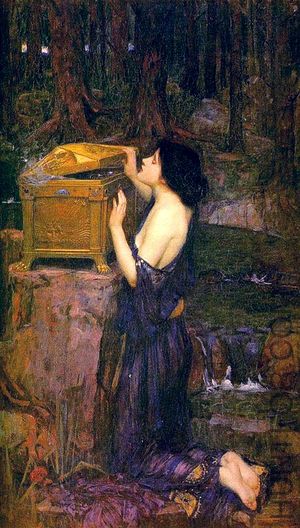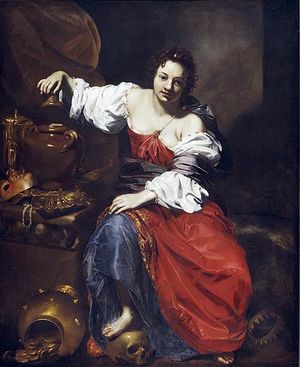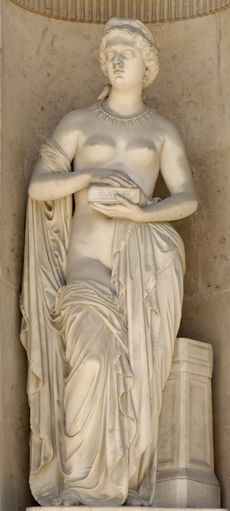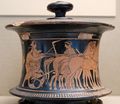پاندورا
هذا الموضوع عن پاندورا (توضيح). من أجل استخدامات أخرى، انظر پاندورا (توضيح).
پاندورا هي أول أمرأة يونانية وجدت علي الأرض طبقا للعقيدة اليونانية. خلقت بامر من زيوس، وتم خلقها حسب الأسطورة من الماء والتراب ومنحت العديد من المزايا مثل الجمال والإقناع و عزف الموسيقى. حسب الأسطورة كان هناك صندوق منعت باندورا من فتحه ولكن حبها للفضول دفعها لفتح الصندق الذي ادى بدوره حسب الأسطورة إلى خروج الشياطين وإنتشارهم في الأرض.

John William Waterhouse: پاندورا، 1896

Nicolas Régnier: Allegory of Vanity — Pandora, c. 1626. Régnier portrayed Pandora with a jar, not a box.
. . . . . . . . . . . . . . . . . . . . . . . . . . . . . . . . . . . . . . . . . . . . . . . . . . . . . . . . . . . . . . . . . . . . . . . . . . . . . . . . . . . . . . . . . . . . . . . . . . . . . . . . . . . . . . . . . . . . . . . . . . . . . . . . . . . . . . . . . . . . . . . . . . . . . . . . . . . . . . . . . . . . . . . .
انظر أيضاً
الهامش
المصادر
- Athanassakis, A. Hesiod: Theogony, Works and Days, Shield (New York 1983).
- Beall, E. "The Contents of Hesiod's Pandora Jar: Erga 94–98," Hermes 117 (1989) 227–30.
- Harrison, Jane Ellen, Prolegomena to the Study of Greek Religion (1903) 1922, pp. 280–85.
- Griffith, Mark. Aeschylus Prometheus Bound Text and Commentary (Cambridge 1983).
- Hesiod, Works and Days On-line text.
- Hesiod, Works and Days, ed. with prolegomena and commentary (Oxford 1978).
- Hesiod, Theogony, and Works and Days (Oxford 1988).
- Kenaan, Pandora's Senses: The Feminine Character of the Ancient Text (Madison, WI: The University of Wisconsin Press, 2008), pp. xii, 253 (Wisconsin Studies in Classics).
- Kirk, G.S., Myth: Its Meaning and Functions in Ancient and Other Cultures (Berkeley 1970) 226–32.
- Lamberton, Robert, Hesiod, New Haven: Yale University Press, 1988. ISBN 0300040687. Cf. Chapter II, "The Theogony", and Chapter III, "The Works and Days", especially pp. 96–103 for a side-by-side comparison and analysis of the Pandora story.
- Leinieks, V. "Elpis in Hesiod, Works and Days 96," Philologus 128 (1984) 1–8.
- Moore, Clifford H. The Religious Thought of the Greeks, 1916.
- Neils, Jenifer, The Girl in the Pithos: Hesiod’s Elpis, in "Periklean Athens and its Legacy. Problems and Perspectives", eds. J. M. Barringer and J. M. Hurwit (Austin : University of Texas Press), 2005, pp. 37–45.
- Nilsson, Martin P. History of Greek Religion, 1949.
- Phipps, William E., Eve and Pandora Contrasted, in Theology Today, v.45, n.1, April 1988, Princeton: Princeton Theological Seminary.
- Pucci, Pietro, Hesiod and the Language of Poetry (Baltimore 1977)
- Rose, Herbert Jennings, A Handbook of Greek Literature; From Homer to the Age of Lucian, London, Methuen & Co., Ltd., 1934. Cf. especially Chapter III, Hesiod and the Hesiodic Schools, p. 61
- Smith, William, Dictionary of Greek and Roman Biography and Mythology, 1870, sub "Pandora" On-line text
- William Smith, Dictionary of Greek and Roman Biography and Mythology (1870) vol I:177, sub "Anesidora" "Spender" is a misprint of "sender", often repeated.
- Verdenius, Willem Jacob, A Commentary on Hesiod Works and Days vv 1–382 (Leiden: E.J. Brill, 1985). ISBN 9004074651. This work has a very in-depth discussion and synthesis of the various theories and speculations about the Pandora story and the jar. Cf. p. 62 and onwards.
- Vernant, J. P., Myth and Society in Ancient Greece (New York 1990) 183–201.
- Warner, M., Monuments and Maidens: The Allegory of the Female Form (New York 1985) 213–40
- West, M. L. Hesiod, Theogony, ed. with prolegomena and commentary (Oxford 1966).
- West, M. L. Hesiod, Works and Days, ed. with prolegomena and commentary (Oxford 1978).
- Zeitlin, Froma. Playing the Other: Gender and Society in Classical Greek Literature (Princeton 1995).
وصلات خارجية
المصادر
الكلمات الدالة:



